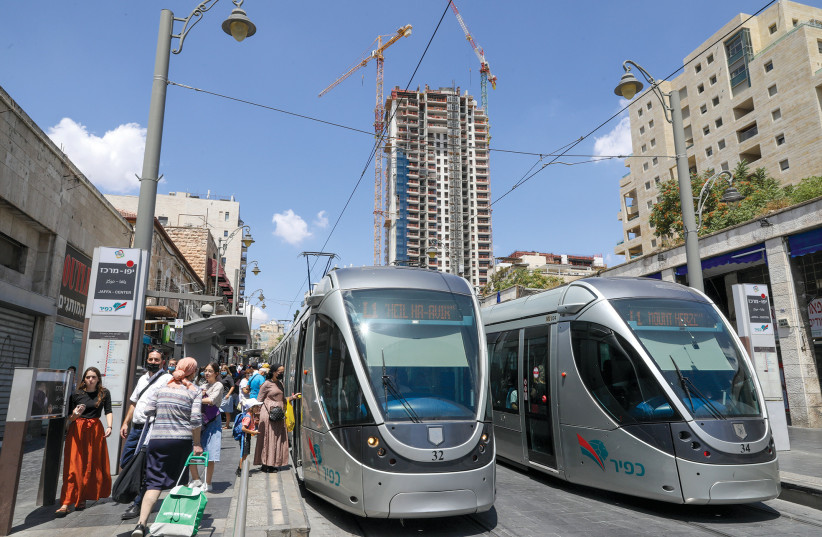We have a winner
A concessionaire was chosen to operate the light rail’s Blue Line. –the Spanish JTrain company, which consists of Israeli companies Danya Cebus and Dan, together with the Spanish COMSA. The Blue Line is the third and longest line of the capital’s light rail system,. It is expected to be in full operation by 2030.
A joint committee of the Finance and Transport ministries and the Jerusalem Municipality awarded the tender to JTrain, an ad-hoc company established for the benefit of the Blue Line project. The tender was based on the PPP (public-private partnership) method, within which framework JTrain will build, operate, maintain, and finance the project for seven years with an option to operate it for 18 more years, while maintaining the network for 25 years.
The planning and infrastructure work for the construction of the Blue Line has already begun. The operation of the line will be carried out, according to the tender, in stages from 2028 until its full operation in 2030. The line will be 31 km., connecting Gilo and Talpiot in the south of the city to Ramat Eshkol and Ramot in the north, with 53 stations. The line will pass through ultra-Orthodox neighborhoods and thus is expected to be partly underground (a 2 km.-long section from Jaffa Street to Sanhedria with three stations), hence more protest is expected there.
The company will build a light rail depot in Malha, which will house a fleet of 66 new trains produced by the Polish PESA company. When the Blue Line is completed, Jerusalem will offer eight light rail routes using the main Red (which is already operating), Green (which is expected to start operating in 2025), and Blue lines, along with secondary lines that will connect to the main lines.
According to the municipality, the network will be an advanced transportation solution that will lead to a substantial upgrade and improvement in Jerusalem, enabling the city’s residents and visitors to enjoy a smart and connected transportation system that’s accessible, available, comfortable, and reliable. With the completion of the Blue Line, the light rail system in Jerusalem will transport between 500,000 to 600,000 passengers daily.

Our gates
As part of the renewal project for the entrance to the capital, the National Insurance Institute (Bituah Leumi) will receive a new home that will consolidate all its offices scattered throughout the city. According to the plan, an eight-story underground building and a 30-story office tower will be built, for which the construction will begin in the coming days. The new NII headquarters will house the three management branches currently in the capital, as well as the Jerusalem branch, which provides service to the city’s residents and is now divided into several buildings.
Meanwhile, management employees moved to another rented building, the Israel Post building close to the Central Bus Station, and will remain there until the excavation and construction of the new building is completed, within five to seven years.
Jerusalem March
As part of the traditional Sukkot events, tens of thousands of people from Israel and abroad are expected to participate in the Jerusalem March taking place Wednesday, October 4. The 68th annual march will consist of three routes, alongside an event that will be held at Sacher Park. Between 1:30 and 6 p.m., the following streets will be closed to vehicle traffic: Ben-Zvi (in the section between Agrippas and Ruppin intersection); Sderot Rabin, Bezalel, Ben-Yehuda, Shmuel Hanagid, Bari, King George, Agron, Hillel, Ben-Sira, King David, and David Remez.
Also, parking on the following streets will be prohibited on Tuesday, a day before the march: Ben-Zvi, Hillel, Ben-Sira, and King David. The municipality has made it clear that vehicles that are parked along the route of the march will be towed to Independence Park or another municipal lot.
Changes will also apply to the public transportation lines passing through the streets leading to them: Bezalel, Ben-Zvi, King George, Eliash, King David, Karib, King Solomon, Agron, David Remez, and Keren Hayesod. The service will be diverted to the streets of Agrippas, Ha’neviim, Shivtei Yisrael, the IDF Tunnel, Derech Hebron, Rabin, and the Hall of Justice.
On Wednesday, between 10 a.m. and 4 p.m., a festive event will be held in Sacher Park, during which the public can enjoy shows, musical ensembles, and artists. And children are invited to a special complex for them with dance shows, inflatables, circus shows, a drum circle, a magic show, a band, dance and singing groups, gymnastics and acrobatics shows, and more.
The parade will include marching bands, IDF soldiers, street artists, dance troupes, and more. The parade will end at around 5:30 p.m. ❖
